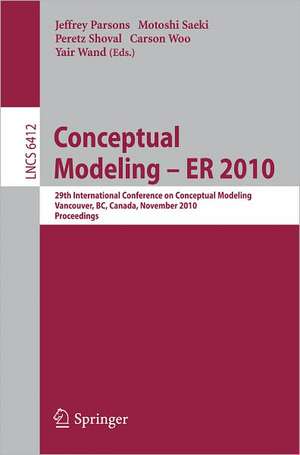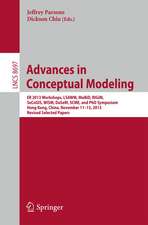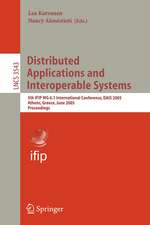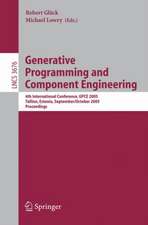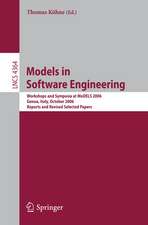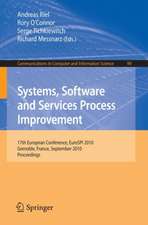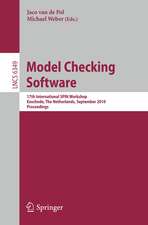Conceptual Modeling – ER 2010: 29th International Conference on Conceptual Modeling, Vancouver, BC, Canada, November 1-4, 2010, Proceedings: Lecture Notes in Computer Science, cartea 6412
Editat de Jeffrey Parsons, Motoshi Saeki, Peretz Shoval, Carson Woo, Yair Wanden Limba Engleză Paperback – 19 oct 2010
Din seria Lecture Notes in Computer Science
- 20%
 Preț: 1061.55 lei
Preț: 1061.55 lei - 20%
 Preț: 307.71 lei
Preț: 307.71 lei - 20%
 Preț: 438.69 lei
Preț: 438.69 lei - 20%
 Preț: 645.28 lei
Preț: 645.28 lei -
 Preț: 410.88 lei
Preț: 410.88 lei - 15%
 Preț: 580.46 lei
Preț: 580.46 lei - 17%
 Preț: 427.22 lei
Preț: 427.22 lei - 20%
 Preț: 596.46 lei
Preț: 596.46 lei -
 Preț: 381.21 lei
Preț: 381.21 lei - 20%
 Preț: 353.50 lei
Preț: 353.50 lei - 20%
 Preț: 1414.79 lei
Preț: 1414.79 lei - 20%
 Preț: 309.90 lei
Preț: 309.90 lei - 20%
 Preț: 583.40 lei
Preț: 583.40 lei - 20%
 Preț: 1075.26 lei
Preț: 1075.26 lei - 20%
 Preț: 310.26 lei
Preț: 310.26 lei - 20%
 Preț: 655.02 lei
Preț: 655.02 lei - 20%
 Preț: 580.93 lei
Preț: 580.93 lei - 20%
 Preț: 340.32 lei
Preț: 340.32 lei - 15%
 Preț: 438.59 lei
Preț: 438.59 lei - 20%
 Preț: 591.51 lei
Preț: 591.51 lei - 20%
 Preț: 649.49 lei
Preț: 649.49 lei - 20%
 Preț: 337.00 lei
Preț: 337.00 lei -
 Preț: 449.57 lei
Preț: 449.57 lei - 20%
 Preț: 607.39 lei
Preț: 607.39 lei - 20%
 Preț: 1024.44 lei
Preț: 1024.44 lei - 20%
 Preț: 579.30 lei
Preț: 579.30 lei - 20%
 Preț: 763.23 lei
Preț: 763.23 lei - 20%
 Preț: 453.32 lei
Preț: 453.32 lei - 20%
 Preț: 575.48 lei
Preț: 575.48 lei - 20%
 Preț: 585.88 lei
Preț: 585.88 lei - 20%
 Preț: 825.93 lei
Preț: 825.93 lei - 20%
 Preț: 763.23 lei
Preț: 763.23 lei - 17%
 Preț: 360.19 lei
Preț: 360.19 lei - 20%
 Preț: 1183.14 lei
Preț: 1183.14 lei - 20%
 Preț: 340.32 lei
Preț: 340.32 lei - 20%
 Preț: 504.57 lei
Preț: 504.57 lei - 20%
 Preț: 369.12 lei
Preț: 369.12 lei - 20%
 Preț: 583.40 lei
Preț: 583.40 lei - 20%
 Preț: 343.62 lei
Preț: 343.62 lei - 20%
 Preț: 350.21 lei
Preț: 350.21 lei - 20%
 Preț: 764.89 lei
Preț: 764.89 lei - 20%
 Preț: 583.40 lei
Preț: 583.40 lei -
 Preț: 389.48 lei
Preț: 389.48 lei - 20%
 Preț: 341.95 lei
Preț: 341.95 lei - 20%
 Preț: 238.01 lei
Preț: 238.01 lei - 20%
 Preț: 538.29 lei
Preț: 538.29 lei
Preț: 344.10 lei
Preț vechi: 430.12 lei
-20% Nou
Puncte Express: 516
Preț estimativ în valută:
65.85€ • 67.44$ • 54.78£
65.85€ • 67.44$ • 54.78£
Carte disponibilă
Livrare economică 26 februarie-12 martie
Preluare comenzi: 021 569.72.76
Specificații
ISBN-13: 9783642163722
ISBN-10: 3642163726
Pagini: 504
Ilustrații: XIV, 490 p. 163 illus.
Greutate: 0.74 kg
Ediția:2010
Editura: Springer Berlin, Heidelberg
Colecția Springer
Seriile Lecture Notes in Computer Science, Information Systems and Applications, incl. Internet/Web, and HCI
Locul publicării:Berlin, Heidelberg, Germany
ISBN-10: 3642163726
Pagini: 504
Ilustrații: XIV, 490 p. 163 illus.
Greutate: 0.74 kg
Ediția:2010
Editura: Springer Berlin, Heidelberg
Colecția Springer
Seriile Lecture Notes in Computer Science, Information Systems and Applications, incl. Internet/Web, and HCI
Locul publicării:Berlin, Heidelberg, Germany
Public țintă
ResearchCuprins
Business Process Modeling.- Meronymy-Based Aggregation of Activities in Business Process Models.- Leveraging Business Process Models for ETL Design.- Adaptation in Open Systems: Giving Interaction Its Rightful Place.- Requirements Engineering and Modeling 1.- Information Use in Solving a Well-Structured IS Problem: The Roles of IS and Application Domain Knowledge.- Finding Solutions in Goal Models: An Interactive Backward Reasoning Approach.- The Model Role Level – A Vision.- Requirements Engineering and Modeling 2.- Establishing Regulatory Compliance for Information System Requirements: An Experience Report from the Health Care Domain.- Decision-Making Ontology for Information System Engineering.- Reasoning with Optional and Preferred Requirements.- Data Evolution and Adaptation.- A Conceptual Approach to Database Applications Evolution.- Automated Co-evolution of Conceptual Models, Physical Databases, and Mappings.- A SchemaGuide for Accelerating the View Adaptation Process.- Operations on Spatio-temporal Data.- Complexity of Reasoning over Temporal Data Models.- Using Preaggregation to Speed Up Scaling Operations on Massive Spatio-temporal Data.- Situation Prediction Nets.- Model Abstraction, Feature Modeling, and Filtering.- Granularity in Conceptual Modelling: Application to Metamodels.- Feature Assembly: A New Feature Modeling Technique.- A Method for Filtering Large Conceptual Schemas.- Integration and Composition.- Measuring the Quality of an Integrated Schema.- Contextual Factors in Database Integration — A Delphi Study.- Building Dynamic Models of Service Compositions with Simulation of Provision Resources.- Consistency, Satisfiability and Compliance Checking.- Maintaining Consistency of Probabilistic Databases: A Linear Programming Approach.- FullSatisfiability of UML Class Diagrams.- On Enabling Data-Aware Compliance Checking of Business Process Models.- Using Ontologies for Query Answering.- Query Answering under Expressive Entity-Relationship Schemata.- SQOWL: Type Inference in an RDBMS.- Querying Databases with Taxonomies.- Document and Query Processing.- What Is Wrong with Digital Documents? A Conceptual Model for Structural Cross-Media Content Composition and Reuse.- Classification of Index Partitions to Boost XML Query Performance.- Specifying Aggregation Functions in Multidimensional Models with OCL.- Demos and Posters.- The CARD System.- AuRUS: Automated Reasoning on UML/OCL Schemas.- How the Structuring of Domain Knowledge Helps Casual Process Modelers.- SPEED: A Semantics-Based Pipeline for Economic Event Detection.- Prediction of Business Process Model Quality Based on Structural Metrics.- Modelling Functional Requirements in Spatial Design.- Business Processes Contextualisation via Context Analysis.- A Generic Perspective Model for the Generation of Business Process Views.- Extending Organizational Modeling with Business Services Concepts: An Overview of the Proposed Architecture.
